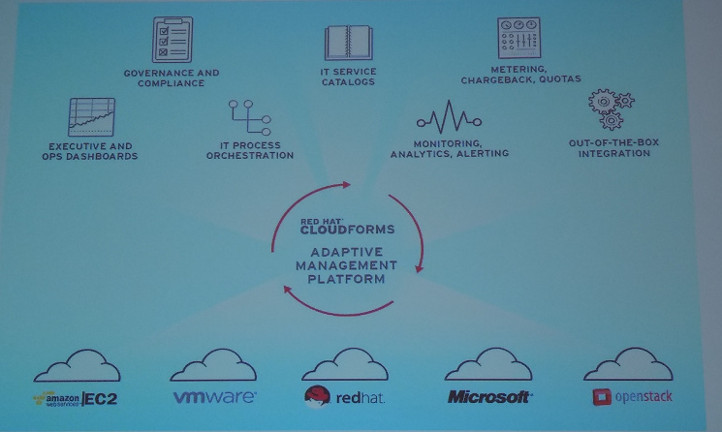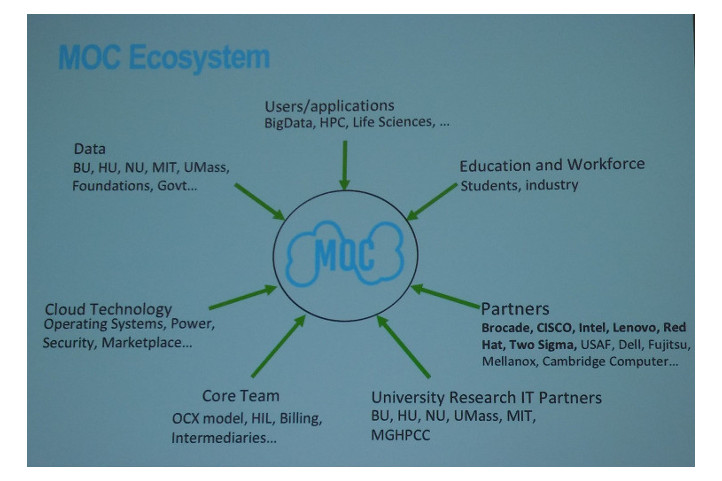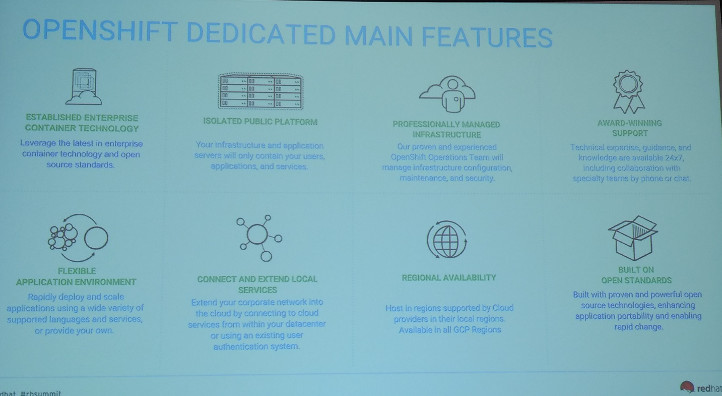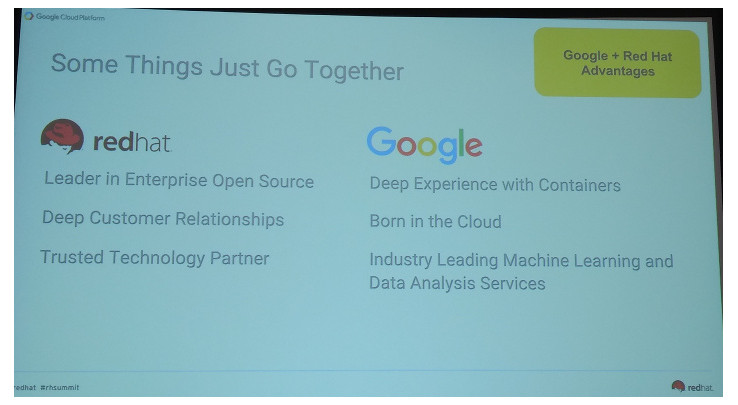The final day of Red Hat® Summit offered even more sessions from Red Hat and its partners and customers on cloud innovation, use cases, and best practices.
From private-sector to educational organizations, presenters offered insight and technical demos—fresh perspectives for attendees to become change catalysts at their own organizations.
Check out some highlights from the day-3 cloud agenda below.
Cloud integration helps retail speed development and streamline management
Companies like BJ’s Wholesale, a retailer that provides in-store and online shopping, are taking advantage of cloud integration capabilities to unite their tools, teams, and apps.
These tools―for networking management and centralized governance to access controls and rapidly scalability―help free hired talent from manual work. But adding components a piece at a time complicates their use. Automation helps unite teams, but new tools in multiple environments can lead to apps created in isolation. According to Phil Avery, architect for BJ’s Wholesale, this fragmentation and complexity delays resource provisioning.

Phil Avery, architect for BJ’s Wholesale
BJ’s Wholesale has used Red Hat CloudForms to centralize automation and management across the retailer’s tools and vendors―from Microsoft Azure and their Red Hat cloud environments to OpenStack® and Puppet.

Red Hat CloudForms centralized automation and management.
Now, BJ’s Wholesale has linked a complex cloud infrastructure of tools, resources, management, and security features across environments and gained self-service capabilities that make developing in the cloud faster.
Open cloud collaboration supports innovative tech research
A team of technology experts and researchers presented on the Massachusetts Open Cloud (MOC), a collaborative effort by Boston University, Harvard, MIT, Northeastern, and UMass to work with Red Hat and other industry partners on a new cloud model.
According to Orran Krieger, a professor at Boston University, cloud’s on-demand access and economic scalability are having a dramatic impact on innovation, but serious challenges remain. The current approach makes transferring data between clouds or providers incredibly difficult: public cloud pricing is high, and―most importantly―users have little to no visibility into their cloud providers’ internal processes.
For academic institutions like Boston University who are undertaking systems research, this lack of transparency into their cloud led them to seek a better approach.
In the MOC, anyone can add a new service to compete on a level playing field, opening cloud development to support innovation and greater efficiency. According to Krieger, this approach could fundamentally change systems research through access to real users and data at varying scale and through visibility into systems.

Massachusetts Open Cloud ecosystem
Resource federation lets users mix and match components. For example, MIT can control parts of cloud service, while Harvard controls others.
Production OpenStack services are now available on the MOC, but other capabilities and features are also planned, including:
- Simple graphical user interface (GUI).
- Support for Red Hat OpenShift.
- Federation across universities.
- Rapid, secure Hardware-as-a-Service.
- 20+PB Network Engineering System Engineering (NESE) data lake.
- Cloud Dataverse, a Big Data-as-a-Service (BDaaS) solution for hosting data sets.
Researchers shared how the MOC supports their innovative work through an end-to-end proof of concept (POC). An effort by Boston Children’s Hospital, Boston University, MOC, and Red Hat supports radiology in the cloud for critical fetal scanning and disease research. This effort requires many machines, but there are plans to containerize the workflow to run in MOC’s OpenShift instance to further streamline performance.
The MOC began as a solution for supporting innovative research, but it has broader application to inspire fundamental transformation of cloud across industries and use cases.
“Open source innovation is driving fundamental transformation of everything.” --Orran Krieger, professor, Boston University
Red Hat and Google partner on container-optimized cloud
Satish Balakrishnan, director of OpenShift Online at Red Hat, and Martin Buhr, product manager at Google Cloud Platform, shared overviews of their companies’ products and how they combine into a solution that offers cost and performance improvements.
Red Hat OpenShift Dedicated offers many features for single-tenant, managed instances, helping users focus on their apps while Red Hat manages your infrastructure.

Red Hat OpenShift Dedicated main features
“It’s an easy sell [to your business teams]. All of the customers here are testament to that.” - Satish Balakrishnan, director of OpenShift Online, Red Hat
Buhr then reviewed Google Cloud Platform, Google’s cloud infrastructure offering that works in tandem with OpenShift as an application layer. Google Cloud Platform offers cost-effective security features and reliability and supports faster app delivery in collaboration with OpenShift.

Google provides infrastructure and container experience, while Red Hat brings experience with delivery and customers.
With the combination of technology and service expertise, this cloud solution offers customers broader cloud capabilities and serves as a foundation for future innovation, benefitting both creators and users. For example, Buhr previewed a planned collaborative offering from Red Hat and Google that combines Open Service Broker API, Red Hat OpenShift, and Google Cloud Platform. (Learn more and demo the solution on Orbitera.)
The clouds are parting
Red Hat Summit 2017 brought exciting news of collaborative cloud offerings from Red Hat and its partners as well as insight from users across industries about putting cloud innovation into practice.
As we learned in Red Hat’s opening keynote, hybrid cloud is integral to the future of enterprise IT, and we expect the pace of innovation to only increase as organizations join the collaborative effort and define new uses for cloud.
--
Miss our other Summit cloud session posts? Check out day 1 and day 2 recaps.
See you next year in San Francisco for Red Hat Summit 2018, May 8-10.
The OpenStack word mark and the Square O Design, together or apart, are trademarks or registered trademarks of OpenStack Foundation in the United States and other countries, and are used with the OpenStack Foundation’s permission. Red Hat, Inc. is not affiliated with, endorsed by, or sponsored by the OpenStack Foundation or the OpenStack community.
Sobre el autor
Red Hat is the world’s leading provider of enterprise open source software solutions, using a community-powered approach to deliver reliable and high-performing Linux, hybrid cloud, container, and Kubernetes technologies.
Red Hat helps customers integrate new and existing IT applications, develop cloud-native applications, standardize on our industry-leading operating system, and automate, secure, and manage complex environments. Award-winning support, training, and consulting services make Red Hat a trusted adviser to the Fortune 500. As a strategic partner to cloud providers, system integrators, application vendors, customers, and open source communities, Red Hat can help organizations prepare for the digital future.
Más similar
Navegar por canal
Automatización
Las últimas novedades en la automatización de la TI para los equipos, la tecnología y los entornos
Inteligencia artificial
Descubra las actualizaciones en las plataformas que permiten a los clientes ejecutar cargas de trabajo de inteligecia artificial en cualquier lugar
Nube híbrida abierta
Vea como construimos un futuro flexible con la nube híbrida
Seguridad
Vea las últimas novedades sobre cómo reducimos los riesgos en entornos y tecnologías
Edge computing
Conozca las actualizaciones en las plataformas que simplifican las operaciones en el edge
Infraestructura
Vea las últimas novedades sobre la plataforma Linux empresarial líder en el mundo
Aplicaciones
Conozca nuestras soluciones para abordar los desafíos más complejos de las aplicaciones
Programas originales
Vea historias divertidas de creadores y líderes en tecnología empresarial
Productos
- Red Hat Enterprise Linux
- Red Hat OpenShift
- Red Hat Ansible Automation Platform
- Servicios de nube
- Ver todos los productos
Herramientas
- Training y Certificación
- Mi cuenta
- Soporte al cliente
- Recursos para desarrolladores
- Busque un partner
- Red Hat Ecosystem Catalog
- Calculador de valor Red Hat
- Documentación
Realice pruebas, compras y ventas
Comunicarse
- Comuníquese con la oficina de ventas
- Comuníquese con el servicio al cliente
- Comuníquese con Red Hat Training
- Redes sociales
Acerca de Red Hat
Somos el proveedor líder a nivel mundial de soluciones empresariales de código abierto, incluyendo Linux, cloud, contenedores y Kubernetes. Ofrecemos soluciones reforzadas, las cuales permiten que las empresas trabajen en distintas plataformas y entornos con facilidad, desde el centro de datos principal hasta el extremo de la red.
Seleccionar idioma
Red Hat legal and privacy links
- Acerca de Red Hat
- Oportunidades de empleo
- Eventos
- Sedes
- Póngase en contacto con Red Hat
- Blog de Red Hat
- Diversidad, igualdad e inclusión
- Cool Stuff Store
- Red Hat Summit

